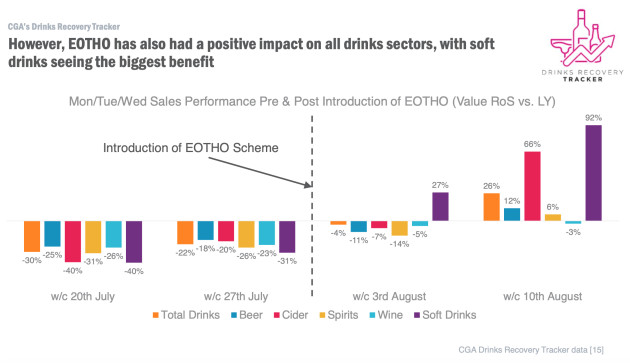
End of Eat Out to Help Out signals new phase for restaurants
Food sales went through the roof in the first three weeks of the government’s The Eat Out to Help Out (EOHO) scheme, helping to normalise going out for Brits and jumpstarting the UK hospitality industry back towards health and prosperity.
As the scheme comes to a close, however, and estimates claim that a third of consumers are looking to scale back their out of home eating and drinking in September (You Gov), a harsh reckoning could be on the horizon for the sector.
The EOHO has exceeded expectations since beginning on 3 August, with sales and the number of claimed dinners steadily rising week-by-week throughout the month.
It also created a halo effect around both end-of-week sales and alcoholic drinks sales, neither of which were covered by the scheme.
Of the data available so far, things reached their peak on Monday 17 August, when food sales were 94% higher than the equivalent Monday in 2019 (CGA’s Volume Pool of 7,000 managed outlets), marking the biggest YOY increase since the initiative’s introduction. Food sales were also up by 86% and 76% on Tuesday and Wednesday (18 and 19 August) respectively.
The steady uplift is also reflected by HMRC figures.
By midnight on 23 August, the Treasury received 87,000 claims totalling £336m for the scheme, up from 14,000 claims worth £53.7m for week one.
As a result of the scheme, which has helped to boost reopenings as well as sales, many restaurants, pubs and other participating outlets have pledged to continue funding the discount themselves into September.
“We can be cautiously optimistic that the momentum it has created may continue into the autumn months”, predicted Rachel Weller, CGA’s head of consumer research and marketing, last week.
Others however, are less optimistic, with many businesses doubtful that the short-term boost has done enough to confront the deepening crisis facing the hospitality industry.
While CGA figures clearly show a major uplift, the accelerated sales during the EOHO period weren’t enough to make up for the hole left by the large number of outlets that still aren’t open.
As of August 19, only 68% of bars and restaurants and 88% of pubs had re-opened their doors, meaning that total sales for the week commencing Monday 17 did not exceed that of last year.
Looking at combined food and drink at managed outlets on the week commencing August 2, sales for outlets that were open rose by 7% versus 2019 and 4% for the week commencing August 10.
Yet, with around 30% of bars and restaurants still closed, total sales for these two weeks were down overall on 2019.
Further pain is being forecasted by institutions like the Office for Budget Responsibility. As a result of slowed economic growth and the end of the furlough scheme in October, the Office is predicting a trebling of the unemployment rate to 12%.
According to Lloyds bank, only 18% of companies expect to retain all the staff they have furloughed.
Hesitancy in the market is also reflected in reported consumer confidence rates, which remain diverse despite the uplifting impact of EOHO.
CGA’s Pulse Survey, dated 14 August, shows that the EOHO scheme has been successful in tempting consumers back out from among those whom had previously not visited the market.
Just under 40% of consumers who took advantage of EOHO were first-time visitors to the on-trade since it re-opened, while 70% of consumers visiting venues Monday to Wednesday in August said they visited because of the scheme.
Meanwhile, 84% of consumers said EOHO would encourage them to visit a new restaurant.
Consumer confidence generally remains fragile however, CGA said, for both those who have visited the market and those who are yet to do so.
Both groups are concerned about going back to their local area (67% and 69% respectively) as well as about a second wave of infections (75% and 80%).
While the scheme has helped to reassure hesitant consumers that they can have a safe experience in restaurants, pubs, cafes and other venues, with ‘safety over experience’ remaining the priority, it’s clear that a tough final quarter is on the horizon for the UK hospitality and wider drinks industry.
This will be one of the topics of Harpers’ latest webinar, Investing for the Future, where an expert panel will be discussing the long-term costs of short-term cutbacks and how business can box clever in times of economic stress.
Tune in this Thursday 3 September at 2pm to hear the Harpers’ hosted panel, including from Facebook, Enotria, the IPA, Graft Wine and Phipps PR.
Sign up here.
Keywords:
- UK
- CGA
- sales
- HMRC
- industry
- consumers
- consumer confidence
- week
- YOY
- Consumer
- scheme
- uk hospitality
- term
- visited
- august
- EOHO
- food sales
- 000 claims
- restaurants pubs
- new restaurant consumer
- visiting venues monday
- consumers visiting venues
- 14 august shows
- first time visitors




